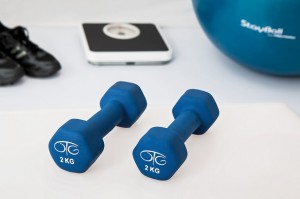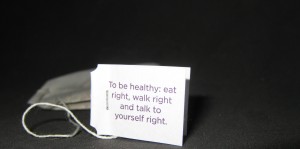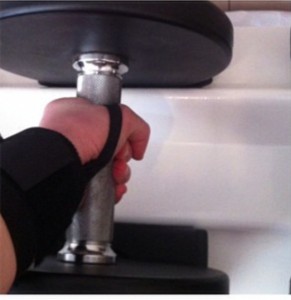Many people consider weight training and cardio as two separate entities; cardio is for burning calories while strength training is for gaining weight, right? Well, not necessarily. If you’ve been following this series of “Women and Weights” you’ve learned that strength training may in fact be an altogether superior method of fat burning (I’d like to point out that when I refer to weights I am using it as a general term to describe any type of resistance training, including free-weights, machines, resistance bands, or bodyweight). This is not to say that running, or any other type of steady-state cardio is ‘bad,’ but it certainly isn’t the only way of reaching your fitness goals. In fact, hitting the weights can actually improve running and other athletic performance significantly. Here’s how:
IMPROVED SPEED
Strength training has been shown to help improve speed in both short and long distance runners. As you build and grow your muscles they become better able to exert more  force in quicker time periods. Strong legs help with that extra push, a strong core aids in balance and stability, and upper body strength helps maintain that speed. This was proven in a study done that tested the correlation between explosive strength training and 5-km running time in endurance athletes. In the experiment, 18 endurance athletes trained for 9 weeks. While both groups kept the same training volume, 10 of these subjects trained with simultaneous explosive strength training and endurance training, while the other 8 subjects participated in endurance training only. 5K time was improved in the well-trained endurance athletes who participated in simultaneous explosive strength training and endurance training due to improved neuromuscular characteristics.
force in quicker time periods. Strong legs help with that extra push, a strong core aids in balance and stability, and upper body strength helps maintain that speed. This was proven in a study done that tested the correlation between explosive strength training and 5-km running time in endurance athletes. In the experiment, 18 endurance athletes trained for 9 weeks. While both groups kept the same training volume, 10 of these subjects trained with simultaneous explosive strength training and endurance training, while the other 8 subjects participated in endurance training only. 5K time was improved in the well-trained endurance athletes who participated in simultaneous explosive strength training and endurance training due to improved neuromuscular characteristics.
IMPROVED CARDIOVASCULAR ENDURANCE
Cardiovascular endurance is the ability of your heart, lungs and blood vessels to efficiently deliver oxygen to your body tissues for use as energy. Believe it or not, resistance training actually increases the body’s ability to use oxygen. In one study that tested the effects of concurrent endurance and strength training on running economy, endurance athletes who incorporated both running and strength training into their routine improved their performance whereas endurance athletes who did not incorporate strength training had no change in performance. These results are congruent with many other previous studies of the same nature.
DECREASE BODY FAT WHILE MAINTAINING MUSCLE
Lifting weights is a great way to burn body fat. Now, cardio certainly does burn a significant amount of calories, however, those calories stop burning off as soon as that hour or so of cardio is finished. With strength training, lean muscle mass is built, which aides in the body not only burning calories during periods of exercise, but also while that person is at rest! Clearly, a body with more lean muscle and less fat is going to be lighter, aiding in speed and also in better body composition.
a great way to burn body fat. Now, cardio certainly does burn a significant amount of calories, however, those calories stop burning off as soon as that hour or so of cardio is finished. With strength training, lean muscle mass is built, which aides in the body not only burning calories during periods of exercise, but also while that person is at rest! Clearly, a body with more lean muscle and less fat is going to be lighter, aiding in speed and also in better body composition.
It is well known that many runners, especially elite runners who engage in intense bouts of physical activity, burn off a lot of muscle due to the extreme forms of cardio. Strength training can help to counter this problem, but won’t result in a significant amount of muscle gain because the continued endurance training will hinder muscle hypertrophy. So for those distance athletes who do not want gains to slow them down, no worries, strength training won’t add on significant size!
INJURY PREVENTION
Engaging in resistance training not only helps to strengthen and build the muscles, but it also helps to equalize them. Many times people are weaker on their left (or non-dominant) side which can cause a runners stride to be off key, or they have muscle imbalances somewhere in the body. Lifting weights helps to equalize strength and power within the legs and the rest of the body, which helps prevent future injuries. The benefits of strength training on injury prevention was shown in a study testing hamstring injury occurrence in elite soccer players after preseason strength training with eccentric overload. The study revealed that preseason strength training for the hamstrings would have positive impacts on the player’s performance and injury prevention.
Strength training is one of the most beneficial workouts to engage in, especially when combined with other forms of working out such as endurance running, sprinting, and other types of cardio. It helps to improve many aspects of performance including speed, cardiovascular fitness, proportion of lean muscle to body fat, and to decrease likelihood of injury. To all of my runners out there, take even just 3 days per week and add some resistance training to your fitness regiment and see how you can benefit!
References
Askling, Carl, Jon Karlsson, and Alf Thorstensson. “Hamstring injury occurrence in elite soccer players after preseason strength training with eccentric overload.” Scandinavian journal of medicine & science in sports 13.4 (2003): 244-250.
Millet, G. P., Jaouen, B. E. R. N. A. R. D., Borrani, F. A. B. I. O., & Candau, R. O. B. I. N. (2002). Effects of concurrent endurance and strength training on running economy and VO~ 2 kinetics. Medicine and science in sports and exercise, 34(8), 1351-1359.
Paavolainen, L., Häkkinen, K., Hämäläinen, I., Nummela, A., & Rusko, H. (1999). Explosive-strength training improves 5-km running time by improving running economy and muscle power. Journal of applied physiology, 86(5), 1527-1533.



 build muscle, strength, or changing their appearance. A twice per week training frequency is when each muscle group is worked twice per week. This is ideal for intermediate and advanced trainees with any type of goal. A three times per week training frequency is when each muscle group is worked three times per week and is ideal for beginners with any type of goal.
build muscle, strength, or changing their appearance. A twice per week training frequency is when each muscle group is worked twice per week. This is ideal for intermediate and advanced trainees with any type of goal. A three times per week training frequency is when each muscle group is worked three times per week and is ideal for beginners with any type of goal. force in quicker time periods. Strong legs help with that extra push, a strong core aids in balance and stability, and upper body strength helps maintain that speed. This was proven in a study done that tested the correlation between explosive strength training and 5-km running time in endurance athletes. In the experiment, 18 endurance athletes trained for 9 weeks. While both groups kept the same training volume, 10 of these subjects trained with simultaneous explosive strength training and endurance training, while the other 8 subjects participated in endurance training only. 5K time was improved in the well-trained endurance athletes who participated in simultaneous explosive strength training and endurance training due to improved neuromuscular characteristics.
force in quicker time periods. Strong legs help with that extra push, a strong core aids in balance and stability, and upper body strength helps maintain that speed. This was proven in a study done that tested the correlation between explosive strength training and 5-km running time in endurance athletes. In the experiment, 18 endurance athletes trained for 9 weeks. While both groups kept the same training volume, 10 of these subjects trained with simultaneous explosive strength training and endurance training, while the other 8 subjects participated in endurance training only. 5K time was improved in the well-trained endurance athletes who participated in simultaneous explosive strength training and endurance training due to improved neuromuscular characteristics. a great way to burn body fat. Now, cardio certainly does burn a significant amount of calories, however, those calories stop burning off as soon as that hour or so of cardio is finished. With strength training, lean muscle mass is built, which aides in the body not only burning calories during periods of exercise, but also while that person is at rest! Clearly, a body with more lean muscle and less fat is going to be lighter, aiding in speed and also in better body composition.
a great way to burn body fat. Now, cardio certainly does burn a significant amount of calories, however, those calories stop burning off as soon as that hour or so of cardio is finished. With strength training, lean muscle mass is built, which aides in the body not only burning calories during periods of exercise, but also while that person is at rest! Clearly, a body with more lean muscle and less fat is going to be lighter, aiding in speed and also in better body composition.

